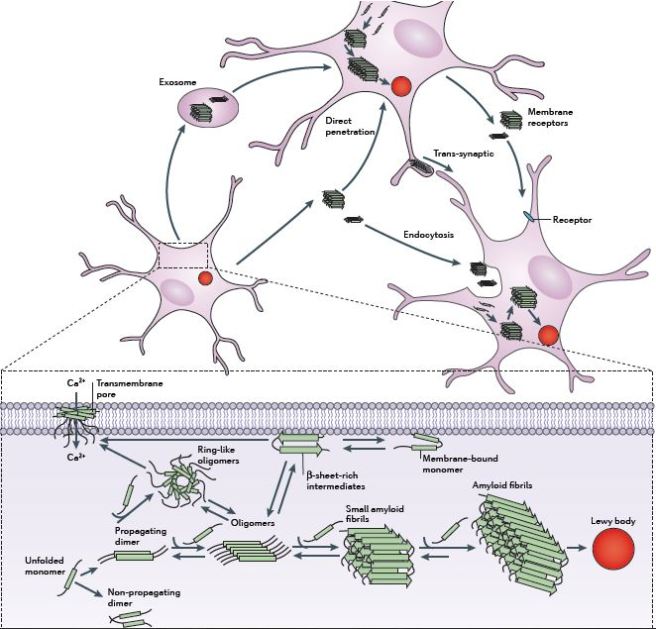Often at the Science of Parkinson’s disease, we will discuss something called ‘Alpha Synuclein’. It sounds a lot like a distant star, but it may well be one of the main villains in this terrible disease.
So what is Alpha Synuclein?
Alpha synuclein. Source: Wikipedia
Alpha-synuclein is a protein.
Proteins make up the many pieces of machinery inside each cell that makes our brains work. In order for each protein to function properly, they must be folded into the correct shape when they are first made.
Alpha synuclein is extremely abundant in our brains – making up about 1% of all the proteins floating around in each neuron (one of the main types of cell in the brain).
In healthy brain cells, correctly constructed alpha synuclein is typically found just inside the surface of membrane surrounding the cell body and in the tips of the branches extending from the cells (in structures called presynaptic terminals which are critical to passing messages between neurons).
So why is alpha synuclein important in Parkinson’s disease?
Genetic mutations account for 10-20% of the cases in Parkinson’s disease.
Five mutations in the alpha-synuclein gene have been identified which are associated with increased risk of Parkinson’s disease (A53T, A30P, E46K, H50Q, and G51D – these are coordinates for locations on the alpha synuclein gene). Rare duplication or triplication of the gene have also been associated with Parkinson’s disease.
So genetically, Alpha synuclein is associated with Parkinson’s disease. But it is also involved at the protein level.
In brains of many people with Parkinson’s disease, some of the alpha synuclein protein has been found to be folded in the wrong way. These incorrectly constructed versions of alpha synuclein will then clump together in aggregates that we call ‘Lewy bodies’.
What are Lewy bodies?
Lewy bodies are circular clumps of alpha synuclein (and other proteins) that are found in the brains of people with Parkinson’s disease. They are very abundant in areas of the brain that have suffered cell loss, such as the region containing dopamine neurons.
A lewy body (brown with a black arrow) inside a cell. Source: Cure Dementia
Alpha Synuclein and how Lewy body form
We don’t really know how Lewy bodies form.
No one has ever seen the process of lewy body formation and all we can do is speculate. Currently there is a lot of evidence supporting the idea that alpha synuclein can be passed between cells. Once inside the new cell, the alpha synuclein helps to seed the formation of new Lewy bodies, and this is how the disease is believed to progress.
The passing of alpha synuclein between brain cells. Source: Nature
Can we stop the spread of Alpha synuclein and formation of Lewy bodies?
This interesting question is currently being tested in clinical trials around the world.

A small Austrian company called “AFFiRiS” is one of several companies that are currently testing vaccines that target alpha synuclein. The idea is that these vaccines will capture and remove all of the alpha synuclein being passed between cells and thus (hopefully) halt the progress of – or at least slow down – the disease.
Controversies associated with Alpha Synuclein
One of the mysteries about alpha synuclein and its role in Parkinson’s disease is that approximately 10-30% of people over the age of 70 years will have lewy bodies in their brain, but with no problems with motor ability or memory function.
In a large autopsy study that investigated 904 brain, alpha synuclein lesions were observed in only 11.3% (or 106 cases), and of these only 32 had been diagnosed with a neurodegenerative disorder.
Another study found that 8.3% of the aged control brains had alpha-synuclein lesions in them. This would suggest that alpha-synuclein aggregation can be present in both healthy and diseased brains.
In addition, alpha synuclein lesions are not specific to Parkinson’s disease – approximately 50% of people who die with Alzheimer’s disease have been found to have lewy bodies.
This raises the question of whether lewy bodies are a causative agent in the disease, or simply an attempt by the cells to deal with a terrible problem of too much protein (are Lewy bodies simply the rubbish can of the cell?).
A lot of research is being conducted in this area and we will keep you up to date as new data comes to hand.


